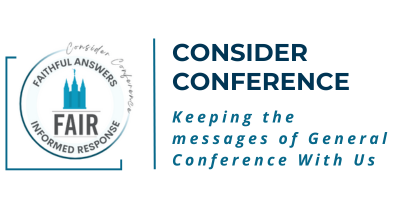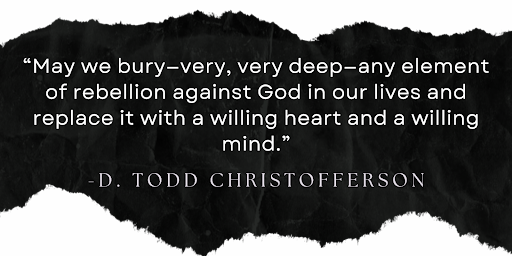
What might we each consider as “weapons of rebellion” in our own lives? Elder D. Todd Christofferson’s talk, “Burying Our Weapons of Rebellion,” invites each of us to lay aside any resistance we feel toward God’s will. Rebellion, whether active or passive, can manifest in ways we might not immediately recognize (see Rebellion, Rebel). For those struggling with doubts, questions, or a tendency to disregard divine direction, Elder Christofferson’s words offer a path back to peace through repentance, humility, and surrender to God’s guidance. His talk draws on powerful stories from the Book of Mormon and Church history, reminding us that no one’s past is beyond God’s reach.
Rebellion, as explained in the talk, includes anything that draws us away from God. This includes passive resistance, such as choosing our own path over God’s. Elder Christofferson gently clarifies that this isn’t about strict conformity but about learning humility.
This message resonates with the Come, Follow Me curriculum for this week as we study Mormon 1-6, where we see the devastating effects of hard-heartedness. Elder Christofferson encourages us to examine our own spiritual weapons, from resentment to self-righteousness, and to replace them with a desire to follow Jesus Christ’s example. Doing so will help us avoid the consequences that arise from hardening our hearts and rebelling against God.
Common Questions, Misconceptions, and Criticisms
In answering critiques and common questions, Elder Christofferson’s message on repentance and alignment with God addresses some of the most frequent misunderstandings about the Church’s teachings on obedience, personal choice, and growth in Christ. Here are some key questions:
Doctrine
-
Question: Does the Church require “blind obedience” from its members?
-
-
- Response: The Church teaches that obedience is a choice grounded in agency and understanding, not coercion. Members are encouraged to ask questions, seek understanding, and willingly align their will with God’s.
- Common Fallacies: This view often reflects a false dilemma—suggesting one can either question everything or obey blindly, without recognizing that members are encouraged to gain and act on their own spiritual confirmations.
-
-
Question: Why does the Church emphasize repentance and humility?
-
- Response: Repentance and humility allow individuals to draw closer to God, fostering a life aligned with divine guidance and peace. The Church views these principles as essential for spiritual growth and happiness.
- Fallacy: This question can reflect appeal to emotion, framing repentance as a negative experience, while the Church views it as a pathway to freedom and joy.
History
Criticism: The Church’s doctrine appears contradictory, especially with figures like William W. Phelps, who repented after betraying Joseph Smith.
- Response: The Church’s teachings emphasize that forgiveness is available to all who genuinely repent, reflecting God’s boundless mercy. Figures like Phelps demonstrate the Church’s belief in the power of transformation.
- Common Fallacies: This type of criticism often uses an anecdotal fallacy, focusing on one individual’s failings without considering the broader doctrine of redemption and repentance.
Misconception: Repentance (and the repentance process) is an attempt to control members’ choices.
- Response: Repentance is a personal, voluntary act; members choose to repent and align with Church teachings. Repentance is not self-condemning, but rather stems from a desire to improve and become more like the Savior. Elder Christofferson teaches that true freedom comes from putting aside rebellious habits and cultivating a willing heart.
- Common Fallacies: This misconception is rooted in the straw man fallacy by presenting repentance as a control mechanism, which distorts its intended purpose of offering peace and growth.
Social Issues
-
Why does the Church have strong views on topics like humility, repentance, and following God’s will?
-
- Response: The Church believes that following God’s will leads to lasting peace and joy. Elder Christofferson uses the example of the Lamanite converts, who laid aside their pride and rebellion, finding spiritual strength and freedom.
- Common Fallacies: Often, this view stems from an appeal to personal autonomy, suggesting that only self-determined paths bring happiness, while the Church teaches that aligning with divine will leads to personal (and social) fulfillment and ultimate joy.
-
Criticism: Why does the Church teach against “doing it your way” and instead focus on obedience to God’s way?
-
- Response: The Church emphasizes obedience to God’s teachings as a means of finding true joy, seeing life as a journey back to God. Personal choice is essential, but Elder Christofferson teaches that lasting peace comes through spiritual surrender.
- Fallacy: This criticism includes the false dichotomy fallacy, where it’s implied that personal choice and following God’s way cannot coexist. The Church teaches that true happiness integrates personal agency with divine guidance.
Leadership
Misconception: Church leaders demand obedience to control members.
- Response: Church leaders encourage members to seek their own answers through prayer and personal study. Obedience to teachings comes through individual conviction, not through compulsion.
- Fallacy: This misconception reflects a hasty generalization by assuming all guidance is enforced rather than offered as counsel for personal spiritual growth.
Question: Why does the Church emphasize loyalty to God’s will instead of focusing on individual paths?
- Response: Loyalty to God’s will is taught as the path to eternal happiness. Elder Christofferson stresses that a self-centered life lacks the peace that comes from yielding to God’s guidance and teachings.
- Fallacy: This question may stem from a begging the question fallacy, presuming that personal paths are inherently more fulfilling without considering the Church’s view of divine fulfillment.
Defending Divine Doctrines
Elder Christofferson’s talk clarifies that repentance and personal agency are not oppositional but complementary. Some key apologetic points:
- Repentance as a Path to Freedom
Elder Christofferson reminds us that freedom comes through surrender to God’s will. His invitation to “lay down the weapons of our rebellion” teaches that we can experience true liberation by removing spiritual barriers. - God’s Mercy and Restoration
Drawing from the example of the Lamanite converts, Elder Christofferson illustrates how forgiveness and transformation work together. This doctrine answers criticisms that view repentance as a “one-size-fits-all” expectation; rather, it’s a deeply personal journey of renewal and discipleship.
Historical and Doctrinal Connections
Contextual Background
In Mormon 1-6, the Nephite prophet Mormon witnesses his people’s decline due to sin and unrepentant hearts. Elder Christofferson references similar spiritual deterioration in the Book of Mormon, noting that a willing heart is central to true conversion.
Resources for Deeper Understanding
For those interested in further study, the following resources expand on Elder Christofferson’s teachings:
- Agency vs Predestination
- LDS.org Lesson on Humility and Forgiveness
- BYU Religious Studies on William W. Phelps and Church History
Living Apologetics
Practical Application
Reflect on what personal “weapons” might hold you back. Whether it’s self-doubt, pride, or something else, Elder Christofferson’s message encourages us to surrender these to Christ. Here are practical ways to implement these ideas:
- Identify one “weapon of rebellion” in your life that you can consciously surrender to God.
- Engage in a sincere prayer asking for help in turning this “weapon” into a tool for good.
- Share your insights with someone you trust, fostering accountability and growth.
Faith in Action
- Application Ideas:
- Reflect on one area of personal resistance to God and write in your journal about how you can overcome it.
- Study scriptural examples of repentance and surrender, focusing on the Lamanite converts’ transformation.
- Meditate on Elder Christofferson’s teachings, focusing on how to yield to God’s will more fully.
Quick Reference: Key Defenses and Facts
Defensive Highlights
- Repentance is freedom: True freedom is found in surrendering rebellion to God.
- Christ’s mercy is limitless: Forgiveness and transformation are available to all who repent.
- Agency remains essential: Members are encouraged to inform themselves and then choose willingly, not to obey blindly.
Top Apologetic Facts
- Freedom Through Repentance: Christofferson teaches that repentance doesn’t limit agency but liberates us.
- Transformation Through Surrender: The Lamanite story illustrates that lasting change comes from yielding our hearts.
- Historical Example: Figures like William W. Phelps exemplify the Church’s belief in redemption and renewal.
Conclusion
Elder Christofferson’s talk, “Burying Our Weapons of Rebellion,” is an invitation to open our hearts to Christ’s peace by surrendering any element of rebellion. Just as the Lamanites transformed their lives through repentance, so too can we. What “weapons” might you lay aside today? Reflecting on this talk can guide us as we seek to better understand our role in God’s plan and feel His peace in our lives.

Share your insight
Your thoughts and experiences can help others along their journey. Share them below, and let’s continue this conversation on sustaining the Savior’s light together.
The Consider Conference series by FAIR offers an in-depth look at recent General Conference talks to help members of the Church of Jesus Christ of Latter-day Saints navigate common questions, misunderstandings, and criticisms. Each post provides doctrinal insights, historical context, and practical ways to apply gospel principles in everyday conversations. Through this series, we hope to equip readers with faith-promoting resources that encourage thoughtful reflection, respectful dialogue, and a stronger foundation in gospel truths, fostering both personal conviction and meaningful discussions with others.


